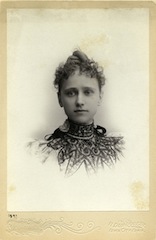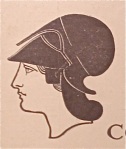
Reproductions and permissions: http://www.iowahistory.org/libraries/services-and-fees/photo-rep…
This biographical sketch was created using information from the following sources:
Bennett, Mary. “Shambaugh, Bertha Maude Horack.” Entry in The Biographical Dictionary of Iowa, edited by David Hudson, Marvin Bergman, and Loren Horton. Iowa City: the University of Iowa Press for the State Historical Society of Iowa, 2008. 452-453.
Christian, Rebecca. “Her Starring Role in Their Polished Show.” The Iowan 39 (Winter 1990): 30-38, 50-51.
Bertha Maude Horack was born in Belle Plaine, Iowa in 1871 to Frank and Katherine Horack, Czech-born immigrants (Bennett, 452; Christian, 32). Her family moved to Iowa City in 1880, when she was nine. Education was important to her parents; as a member of a middle-class family, her father exposed to her music and art, while he mother exposed her to literature (Christian 32). She also attended public schools. At the age of eleven, Bertha became interested in the natural sciences, influenced by family friend and naturalist Bohumil Shimek, and the work of Ralph Waldo Emerson. The detailed drawings that she created of plant specimens were even published in magazines, which attest to her artistic talent and her intelligence (Bennett, 452; Christian 32).
In 1888, at the age of 17, she received a camera, becoming a very competent photographer, combining her technical skill in large-format, dry plate photography with an artistic eye: scholar Karin Becker noted that the lighting in Bertha’s photographs of architectural interiors, as well as her non-traditional sense of balance in her compositions clearly show her to be more than a mere amateur (Christian 34). Bertha took pride in her photography, matting and framing the photographs herself, stamping the images as well.
Her photographs documenting life in the Amana Colonies, a series of seven communitarian villages located about 17 miles from Iowa City, are her most important photographs. She took the majority of these photos, which documented community members’ daily lives, in 1890-91 (Bennett, 452, Christian, 34). Her documentation of the communities reflects the late-19th and early 20th century interest in documenting “dying” cultures, as seen most notably by Edward Curtis’ images of Native Americans. Her photographs and research were eventually published in a 1908 book entitled Amana: Community of True Inspiration (Bennett, 452; Christian 34).
The vast majority of her photography and research on Amana was conducted while she was enrolled as an undergraduate at the State University of Iowa (now the University of Iowa), studying under botanist Thomas Macbride. She was enrolled in college for six years (1889-1895) and in that time, she also began teaching biology at Iowa City High School (Bennett 452). During this time, she also met her husband, Benjamin Shambaugh, marrying him in 1897. He was a professor in the university’s political science department and the first director of the State Historical Society of Iowa (SHSI), an early champion of the importance of local history (Christian, 31).

Reproductions and permissions: http://www.iowahistory.org/libraries/services-and-fees/photo-rep…
Once married, she stopped teaching, like any other middle-class woman of her time. She also switched her energy away from photography and painting, turning her attention to managing her home and promoting Benjamin’s work. Although this upsets me, the social expectations of the time dictated that women stop working once they married, in order to focus their efforts on their family and home. Before getting too upset by Victorian culture, this expectation of women lasted well into the twentieth century. Yet Bertha and Benjamin were both known and well-respected around town. Rebecca Christian describes the couple as “devoted partners both professionally and personally,” though Benjamin’s accomplishments have been more widely documented and praised (Christian, 30).
In 1900, the Shambaughs built a new house near (and now on) the University of Iowa campus, and their home became an intellectual hotspot in town. The couple hosted nationally- and internationally-known public figures and scholars, brought into town by Benjamin for his campus lecture series (Bennett, 452-53). What’s interesting to me about their house is 1) its differences in decoration from her childhood home, which will become apparent in later posts, and 2) in Bertha’s characterization of her home, giving it “a mythical personality” that’s documented in the House Books, a series of scrapbook-inventories that are housed in the University of Iowa’s archives (Christian, 38). I have to get down the road (down the street, really, about seven blocks and a left turn or two) and see these records. Though the house had its own personality, Bertha documents this personality: given her role as woman of the house, she and the house must have had something in common. The relationship that supposedly existed between a woman and her home was one in which she and the home reflected each other, one influencing the other (for better or worse, depending on one’s decorating skills). This idea is discussed by design scholar Beverly Gordon, in her 1996 Winterthur Portfolio article, “Women’s Domestic Body: The Conceptual Conflation of Women and Interiors in the Industrial Age.”
Bertha didn’t give up creative pursuits entirely, especially since she had no children to look after, and her class status afforded her a full-time housekeeper, meaning that she had the time to continue her intellectual and artistic activities (Christian, 32). She played a large role in the early years of the historical society, collecting artifacts, manuscripts, and photographic materials; working in the library; copy editing SHSI publications; and designing book covers for these publications (Christian, 32).
Bertha died in 1952, at the age of 82. I’m concerned mainly with her life between 1888 and about 1938, which is roughly the time period shown in the photographs of the Horack and Shambaugh houses. She’s really a fascinating woman, and a badass amateur artist (images forthcoming).

[…] I’m looking primarily at photographs of domestic interiors and of women at work and leisure around the house, comparing the activities and furnishings found in the interiors to what magazines are telling women about home interiors and what they should be doing in them. For the next couple of weeks, I’ll be looking at Shambaugh Collection of papers, photographs, and objects (so many goodies) belonging to Bertha and Benjamin Shambaugh. You can find more information about Bertha in this post. […]
LikeLike
Bertha and Benjamin are my heroes as they shared a vision for documenting and sharing Iowa history with the masses. Bertha’s talents as a photographer are rarely celebrated so I’m delighted her story will be told here! Thank you, Ms. Truitt, for launching this showcase!
LikeLiked by 1 person
You’ve certainly written your fair share of articles over the years to highlight Bertha, and the lives of many other Iowa women, so THANK YOU, Mary!
LikeLike